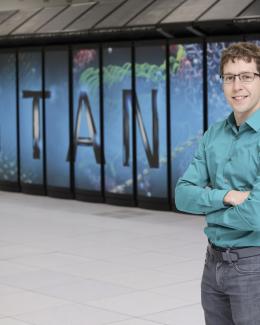
A team from the US Department of Energy’s (DOE’s) Oak Ridge National Laboratory (ORNL) has received a computational research award to model the radiation environment of ITER, the world’s largest fusion reactor, and provide an accurate prediction of whether the shielding design will prevent radiation exposure to workers and equipment.
“To this point there have been very rough calculations of ITER’s global radiation field, but nothing on this scale,” said Seth Johnson, ORNL research scientist and principal investigator of the project. “The challenge is that the size and complexity are extremely high with this machine. You have miniscule components hundreds of meters away from the radiation source, so you need millions and millions of computational mesh cells to provide a high-level model resolution.”
Few computers in the world have the needed power for modeling ITER, so Johnson, along with ORNL’s Tom Evans and Steve Wilson, pursued an award through the Innovative and Novel Computational Impact on Theory and Experiment (INCITE) program that is sponsored by DOE’s Office of Science. Since 2004, the program has granted researchers core hours at DOE Leadership Computing Facilities at Argonne National Laboratory and ORNL.
The work of Johnson, Evans, and Wilson, will take advantage of ORNL’s Titan supercomputer, a 27-petaflop Cray XK7 hybrid system that is the fastest supercomputer in the US for open science. The award will provide 80 million core hours on Titan to execute the project.
“This is the advantage of being a part of ORNL and having access to Titan,” Johnson said. “We have supercomputers within the Reactor and Nuclear Systems Division that have thousands of cores, but for an accurate analysis we needed hundreds of thousands of cores and thankfully we have those available resources.”
ITER is an international undertaking to prove the feasibility of fusion as a source of energy. Thirty-five nations, including the US, are collaborating to build the magnetic fusion device in southern France.
Because of ITER’s size and the use of fusion—as opposed to traditional fission-based reactors that make up the entire US nuclear reactor fleet—this research could be vital in completing construction. Simulations of ITER’s radiation transport have been performed, but they generally provide coarse resolution or only solve over a small piece of the facility. And with fusion reactors, neutrons are emitted at approximately 14 megaelectron volts (MeV), compared with neutron emissions of 1 MeV with a fission reactor. That creates a greater need for shielding because fusion neutrons have a higher penetration capability.
“With ITER, they’re constructing the building, modifying the shielding designs, and coming up with materials all at the same time. Concrete will do the bulk of the shielding, but it’s imperative to know that it will work,” Johnson said. “ITER is also experimental, so there are all types of expensive, very customized equipment that are sensitive to radiation.”
Besides modeling the radiation shield, the team will also benchmark its results to real-world values using information from a smaller fusion reactor called the Joint European Torus (JET), which has measured its radiation environment. The ORNL team will perform simulations of JET to verify the accuracy of its developed model.
“It’s a key part of the project, as we’ll be able to show this is a suitable way to do these analyses,” Johnson said. “If these comparisons end up working, it could open up deterministic methods to be used throughout fusion.”
ORNL is managed by UT-Battelle for the Department of Energy’s Office of Science, the single largest supporter of basic research in the physical sciences in the United States. DOE’s Office of Science is working to address some of the most pressing challenges of our time. For more information, please visit science.energy.gov.



